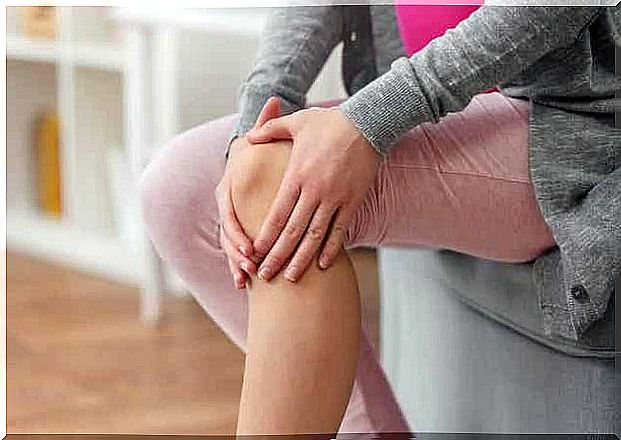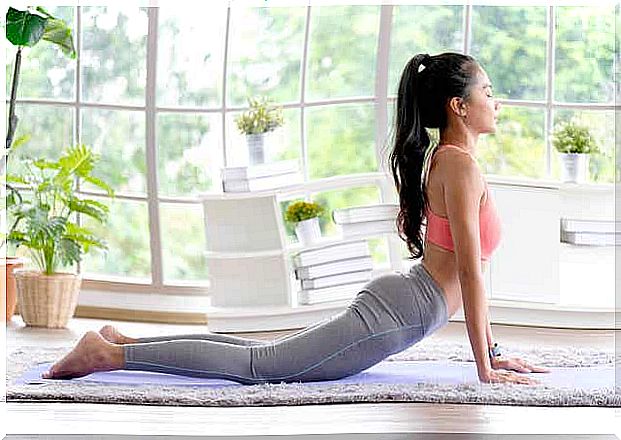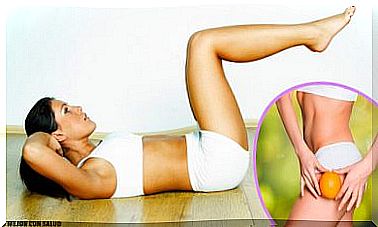Can Yoga Help Against Osteoarthritis And How?

Can yoga help against osteoarthritis? It is an ancient practice that comes from India and is considered a lifestyle rather than a sport or physical activity. The proven benefits of yoga are many and diverse, from maintaining proper posture to helping you cope with everyday stress and various illnesses.
With that in mind, yoga could help with osteoarthritis. In the article below, we’ll look at the symptoms of this condition, as well as some routines you can do at home.
What is osteoarthritis?

Osteoarthritis is a chronic condition that most commonly affects people over the age of 60, but it can affect people of all ages, especially adults.
This disease affects the musculoskeletal system and, in particular, endangers the health of the joints. The most common symptoms of osteoarthritis are:
- Pain when making movements.
- Sensitivity in the area.
- Swelling and stiffness.
- Loss of flexibility.
- Synovitis.
- deformity.
- Osteophyths.
There are several risk factors that experts associate with osteoarthritis, such as age, gender (women are more susceptible), obesity, injuries, stress or overload (in sports and work), as well as genetic factors and some metabolic diseases, such as hemochromatosis, for example.
Osteoarthritis is a disease that develops slowly and progressively and affects the quality of life of those who suffer from it. To date there is no cure.
There is, however, a range of treatments that help against osteoarthritis. They mainly focus on the symptoms and consist of the following:
- Surgical procedure (joint replacement surgery).
- Medications (analgesics and non-steroidal anti-inflammatory drugs, cortisone injections).
- Physiotherapy and rehabilitation.
Some habits also help with osteoarthritis and help treat and manage symptoms, and ultimately prevent its progression.
Does yoga help osteoarthritis?
Practicing yoga is one of the activities that can help improve the symptoms of osteoarthritis. In this regard, the benefits of yoga relate to several factors such as:
- Power and grip.
- Flexibility.
- balance.
- Stress management.
- Feeling of well-being.
- Quality of life.
Therefore, many recommend yoga as an adjunct therapy to conventional treatments for osteoarthritis. But is there any scientific backing for this? Let’s see what the research says about it.
Research into yoga in the treatment of osteoarthritis

A 2019 review on the efficacy of yoga for the treatment of osteoarthritis analyzed studies on this research. These studies included 640 patients aged 50 to 80 years, mostly women, with osteoarthritis of the lower extremities.
The results revealed little evidence for the positive effects of yoga for treating osteoarthritis pain compared to other exercises. There was also no strong evidence of the effects on quality of life. Nevertheless, the researchers consider it advisable to use yoga for osteoarthritis in the knee.
In this regard, another study conducted a meta-analysis of the integrative effect of yoga practice in patients with knee osteoarthritis. The research focused on aspects such as pain reduction, functional recovery and general well-being of patients with this condition in the aforementioned joint.
Significant improvements shown by research
A total of 13 clinical studies were reviewed, involving 1,557 patients with knee osteoarthritis and rheumatoid arthritis. The results indicate that group yoga is helpful in reducing arthritic symptoms, promoting physical function, and improving general well-being.
Specifically in terms of clinical studies, a study of 66 patients aged 30-75 years, who also suffered from knee osteoarthritis, examined the effect of the integrated approach to yoga therapy (IAYT).
The results obtained in the experimental group, which received the yoga therapy intervention, show that there were significant improvements in left grip strength and knee extension, compared to the control group.
Finally, another study on the effects of Hatha yoga on knee osteoarthritis found that after practicing this form of yoga for eight weeks, the results showed a decrease in pain and other symptoms, in addition to an improved performance of daily activities and quality of life.
Yoga to help against osteoarthritis
There are different yoga forms. However, the Arthritis Foundation has some recommendations, as they deem some types of yoga more appropriate for arthritis patients. These include Iyengar yoga, Anusara yoga, Kripalu and Vini yoga.
Also, there are certain yoga routines, exercises and poses that we can perform on our own to relieve the symptoms of osteoarthritis. These exercises include the following:
The mountain pose to help against osteoarthritis
Mountain pose is a very simple exercise. You start with your big toes together and your heels slightly apart. As you take a deep breath, which opens the chest, place your hands, palm to palm, at the level of your heart. Then lift them above your head and point your head towards the sky.
The warrior attitude
The warrior pose is a yoga exercise that works the abs, legs, and buttocks. It consists of the following:
- Stand firmly with your feet apart so that there is more than a meter between the heel of the front foot and the big toe of the back foot.
- Then rotate your leg (to the right if you do it with your right leg and vice versa) and bend your knee. Form a 90 degree angle.
- Then raise your hands up, palms together, as far as possible.
- Finally, take a deep breath and then switch legs.
The cobbler’s pose to help against osteoarthritis
Do this exercise sitting on the floor with your legs stretched out in front of you. Then bend your knees, bring the soles of your feet together and try to bring the heels towards your pelvis.
Drop your knees to the side, without forcing them down, that is, without trying to open them further. Hold this position for a minute. Then straighten your legs and bring your feet back to their original position.
The stick pose
Start in a position similar to the previous one; sitting on the floor with your legs together and straight without bending your knees. If you need to or if you feel more comfortable , you can use a mat to sit on.
Your back should remain firm and erect. Your hands should be next to you, palms facing forward. Likewise, your feet should be straight, with the soles facing forward as well. Stay in this position for a minute.
So, does yoga help with osteoarthritis?

If you suffer from osteoarthritis, yoga is a complementary therapy to consider as an alternative. But yoga cannot replace the treatment your doctor recommends.
It is best to find a professional instructor who has experience working with people with similar symptoms. Also ask your doctor which exercises you can perform.
On the other hand, remember that yoga involves three aspects that we must consider to get the greatest benefit:
- Awareness and breathing techniques.
- Strength, flexibility and balance movements.
- Relaxation and meditation.
As with any other practice, the practice of yoga should also start slowly and remain moderate until you feel your body warm up. That’s why it’s important to warm up first.
Finally, it is imperative that you listen to your body and pay attention to its signals. If you feel pain or discomfort, it means you need to stop. The idea is to reduce pain and improve your quality of life, not the other way around.









